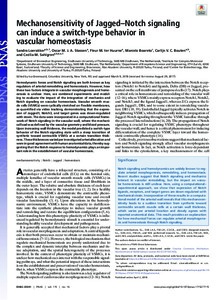Mechanosensitivity of Jagged-Notch signaling can induce a switch-type behavior in vascular homeostasis
Loerakker Sandra; Bouten Carlijn VC; ter Huurne Fleur M; Boareto Marcelo; Sahlgren Cecilia M; Stassen Oscar MJA
Mechanosensitivity of Jagged-Notch signaling can induce a switch-type behavior in vascular homeostasis
Loerakker Sandra
Bouten Carlijn VC
ter Huurne Fleur M
Boareto Marcelo
Sahlgren Cecilia M
Stassen Oscar MJA
NATL ACAD SCIENCES
Julkaisun pysyvä osoite on:
https://urn.fi/URN:NBN:fi-fe2021042719052
https://urn.fi/URN:NBN:fi-fe2021042719052
Tiivistelmä
Hemodynamic forces and Notch signaling are both known as key regulators of arterial remodeling and homeostasis. However, how these two factors integrate in vascular morphogenesis and homeostasis is unclear. Here, we combined experiments and modeling to evaluate the impact of the integration of mechanics and Notch signaling on vascular homeostasis. Vascular smooth muscle cells (VSMCs) were cyclically stretched on flexible membranes, as quantified via video tracking, demonstrating that the expression of Jagged1, Notch3, and target genes was down-regulated with strain. The data were incorporated in a computational framework of Notch signaling in the vascular wall, where the mechanical load was defined by the vascular geometry and blood pressure. Upon increasing wall thickness, the model predicted a switch-type behavior of the Notch signaling state with a steep transition of synthetic toward contractile VSMCs at a certain transition thickness. These thicknesses varied per investigated arterial location and were in good agreement with human anatomical data, thereby suggesting that the Notch response to hemodynamics plays an important role in the establishment of vascular homeostasis.
Kokoelmat
- Rinnakkaistallenteet [19207]
